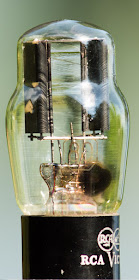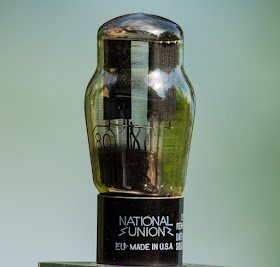Let's have a look at a rectifier tube this month, the 80.
The 80 is a 'classic' full wave rectifier tube. It is directly heated.
 Thus it only needs 4 pins, 2 plates and the 2 filament connections. Which fits on a UX4 base. The pinout is shown on the left. As all the classic rectifiers it has a 5V filament which consumes 2A. It is a rather small rectifier which cannot deliver a lot of current. 135mA max when a choke inout filter is used. Less with a capacitor input filter. For all details regarding the technical specs refer to the data sheet. This rather modest current capability makes it only usable for preamplifiers or small power amps which do not draw a lot of current. A stereo 45 amplifier is about the maximum which comes to mind and that is also what I have used this tube for many years ago before I turned to TV dampers. It could also supply a mono 2A3 single ended amp.
Thus it only needs 4 pins, 2 plates and the 2 filament connections. Which fits on a UX4 base. The pinout is shown on the left. As all the classic rectifiers it has a 5V filament which consumes 2A. It is a rather small rectifier which cannot deliver a lot of current. 135mA max when a choke inout filter is used. Less with a capacitor input filter. For all details regarding the technical specs refer to the data sheet. This rather modest current capability makes it only usable for preamplifiers or small power amps which do not draw a lot of current. A stereo 45 amplifier is about the maximum which comes to mind and that is also what I have used this tube for many years ago before I turned to TV dampers. It could also supply a mono 2A3 single ended amp. Being a classic full wave rectifier it requires a power transformer with a center tapped high voltage winding unless it is augmented with two single diodes to create a bridge rectifier. My samples of this tube had been lying in storage since well over 10 years since the amp I used them in has been dismantled a long time ago. I pulled them out of the drawer to shoot some photos for this post. The 80 has been produced over a very long time. It started it's life in the 1920ies in globe shape as UX280. It adopted the ST shape in the 1930ies and was even packaged in the much slimmer GT tubular bulbs at the end of it's life. It was made by all the major tube manufacturers. Let's start with the gorgeous UX280 made by RCA:
Being a classic full wave rectifier it requires a power transformer with a center tapped high voltage winding unless it is augmented with two single diodes to create a bridge rectifier. My samples of this tube had been lying in storage since well over 10 years since the amp I used them in has been dismantled a long time ago. I pulled them out of the drawer to shoot some photos for this post. The 80 has been produced over a very long time. It started it's life in the 1920ies in globe shape as UX280. It adopted the ST shape in the 1930ies and was even packaged in the much slimmer GT tubular bulbs at the end of it's life. It was made by all the major tube manufacturers. Let's start with the gorgeous UX280 made by RCA:View from another angle:
Close up to the interior:
Here the two plates and the glass stem which aligns the electrode is nicely visible:
View from the top:
Close up to the ribbon filament:
Side view:
The top with the RCA logo:
A Cunningham CX380 also made by RCA:
Detail close up:
More views:
From the top:
Glass stem:
Philco made by Sylvania:
From the side:
Close up showing the ribbon filament:
The plates:
Top:
RCA:
The top:
This one has the plates quite close to each other:
RCA-Victor:
The top:
Another RCA this time with GT straight sided bulb:
Detail close up:
Another view:
The plates look similar to those in the ST shaped RCA shown above:
The GT version is rather small compared to a ST tube:
Raytheon:
The tube with the box:
Ken-Rad:
A JAN-80 made by Sylvania for the military in sealed box:
The box also carries the VT number which in this case is 80 as well (which is not the case for all tubes and can cause confusion).
Apparently this tube was inspected in 58. Which is indicated by the stamp and sticker:
The boy was made such that the tube could be tested without breaking the sealed packaging:
The top flap could be opened.
So the tube could be pushed down a little to expose the pins for testing:
Tung-Sol:
National Union 80:
The plates:
A 80 with the filament lit up:
Close up:
The mica disc obstructs much of the view to the filaments:
Since the globe tubes don't have mica discs they give a much better view to the glow:
I hope you enjoyed this rectifier presentation.
Best regards
Thomas




































































Very nice photography!
ReplyDeleteThank you for this information
ReplyDeleteThis is, like, vintage electronics porn! I'm glad there are still many of us hooked on this subject. Thank you for this great website! It must have taken a lot of time to create, as a labor of love.
ReplyDeleteI agree with Rob above, very nice work on this presentation. I am just starting a relationship with the 80, so finding your Tube of the Month was perfect timing. Thanks
ReplyDeleteDear Thomas
ReplyDeleteWould like to know your thoughts on the EML 80 mesh tube, and how it compares with the nos 80 globe tubes (which I would assume to be the gold standard)?
Also, does using the type 80 tube as a rectifier tube sound better than the 6z3? or is it all just circuit dependent/inconsequential?
Thanks!
Hi! I don't buy new production tubes from other manufacturers ;-) Get the ELROG ER274V :-O
DeleteLate, but, it's a rectifier. It doesn't sound better. It's circuit dependent. Different B+ voltages can sound different and cause the amp to perform differently though. Of course, this voltage can be dependent on the rectifier.
DeleteThis isn't to your comment, but: in general, tube to tube within a part number, all things the same, should sound the same. While differences technically exist (mostly with gain/slight operating point differences/balance in some applications) "rolling 12AX7s", for example, is insanity. Just enjoy the glow!
I just bought a Emission Labs 80. It's big. You have to make sure it will fit. I installed it in my Philco 16B. Absolutely no hum. I am glad I bought it.
ReplyDeleteAn Audio friend here in AZ built me an excellent flea watt ECL86/6GW8 set tube amp that uses a Type 80 rectifier. Really like this amp and have used vintage globe, ST, & slim GT tubes. Would love to try the EML80.
DeleteVery well put together and wonderfully represented. Thank you. I saw my first one yesterday in the back of a rotting table-top radio.
ReplyDeleteHi, I'm new to vintage tech and I am interested to know if there is an alternative to the 80 I could use in a 1939/40 radio, as I cant find any 80's in my price range. Thanks in advance
ReplyDeleteNo direct replacement as far as I know, but you could use a 5V4 or 5Y4 with an socket adaptor
DeleteAES has NOS 80s for $18
Deletehttps://www.tubesandmore.com/products/vacuum-tube-80-rectifier-full-wave-st-glass
If that's too much, there are plenty on ebay for less than $10